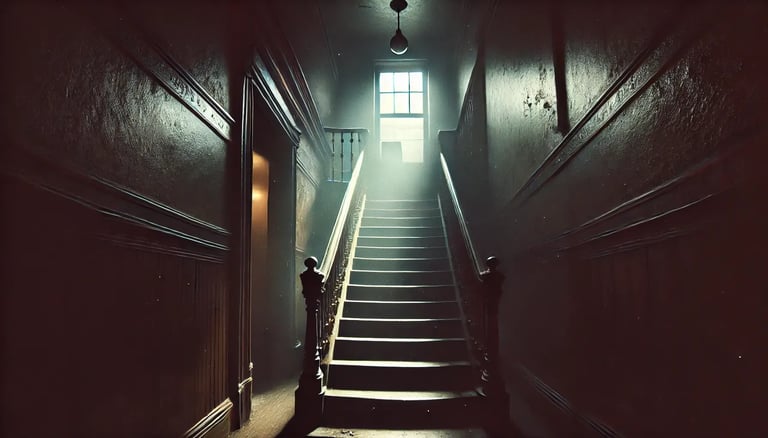The Unquiet Staircase

31.10.2024

William Raynar - regular contributor to FOLIO, delivers The Unquiet Staircase, a haunting tale of tragedy and loss, where the spirits of a doomed family echo through the years, leaving a lasting impression on those who come after. As the past intertwines with the present, this story explores the unshakable presence of grief and its inescapable consequences.
In the waning twilight of a cold November day in 1931, John Donovan stood silently by the window of his modest Brooklyn apartment. His eyes, once vibrant with ambition and hope, were now hollowed by despair. The ravages of the 1929 financial collapse had stripped him of everything; his fortune, his dignity, and, most cruelly, his sense of self. The weight of it all, an unbearable burden, had led him to a most unthinkable act.
Two small figures lay in the bed behind him, his beloved children, their chests now unmoving. Their faces, peaceful in eternal slumber, bore the faint remnants of love and trust, those same expressions that had haunted him since his ruin. How could they gaze upon him, the man who had failed them so profoundly? He had suffocated them gently, as if to ease their pain, but it was his own agony he sought to extinguish. And now, there was but one final step to take.
As the sun slipped below the horizon, John flung himself from the sixth-floor window. His fall was abrupt, but the violent descent was arrested by the iron railing that ran to the basement, mangling his body like a broken puppet, his limbs contorted in a grotesque final tableau.
.webp?width=1792&height=1024&name=%233%20(1).webp)
It was at this moment that Ann, his wife, arrived. She was still in her nurse's uniform, fresh from the night shift, the stark white of her hat gleaming in the dim light of the street. The police were already on the scene, but it was as if she saw nothing of their presence. Her eyes locked onto her husband's twisted form, hanging lifeless like a marionette abandoned by its master. Her heart pounded with a dread that she could not yet name, but her feet carried her not to John but to the children.
She ran up the stairs, the narrow corridor echoing her hurried steps. The apartment door groaned open, and as she entered the children's room, the truth settled upon her like a suffocating fog. Her children, lifeless beneath the weight of their blankets, lay there as if merely asleep. But she knew, deep in the pit of her soul, they had followed their father into the abyss.
For weeks, Ann lingered in a state of catatonia, her once fervent faith abandoned. The priest from the nearby parish visited her often, offering prayers, but she spoke of strange things, delusions, they thought. Ann would sit by the window, her thin, trembling hands resting on the arms of her chair, and speak of her children standing beside her, still in their pyjamas. "They have not gone," she would whisper, her voice trembling, "they are here, always beside me. They... they do not know how to reach heaven."
As the days wore on, Ann wasted away, her body growing gaunt and frail. The spark that had once made her a vibrant, devout woman flickered out, leaving only a shell behind. The morning she was found, in her small kitchen filled with the acrid stench of gas, there was no doubt, Ann had chosen to join her family in the cold embrace of death.
But the story did not end with her
After the war, in 1946, Richard and Louise, a soldier who had survived the blood-soaked beaches of Omaha and a nurse from Alsace, moved into the very same apartment. Life was kind to them for a time, though their hearts bore the scars of war. Years passed before Anna finally gave birth to a son, Willard, in 1955.
When Willard was nearly twelve, strange things began to happen in the stairwell. He would hear footsteps, soft at first, but unmistakable, ascending the stairs, only to stop abruptly outside their door. One winter day, as he was coming back from school, he saw her. A woman, running frantically up the stairs, her face contorted in desperation, her nurse’s hat still perched atop her head. She reached the door, only to vanish before his eyes. It was Ann, doomed to forever repeat her frantic race to the children she could never save.
In 1973, a young property developer purchased the building. The modest structure was torn down, the walls crumbling like the fragile memories contained within. But the past, like the dead, does not rest so easily.
Epilogue
In 1982, Willard, known to the world as Tobe Hooper, captured the lingering essence of haunted homes and restless spirits in his iconic film Poltergeist. The film, chilling and unsettling, tells the tale of a suburban family tormented by malevolent poltergeists who abduct their youngest daughter, Carol-Ann, drawing eerie parallels to the unshakable hauntings of Brooklyn’s past. Poltergeist resonated deeply with audiences, grossing an astonishing $76 million in the United States alone, which would equate to around $250 million today. Its success crowned it the highest-grossing horror film of the year, cementing Hooper's legacy in cinematic horror.
But what few recall is that the modest building where John, Ann, and their children once lived, where so much tragedy had unfolded, was destined to be torn down by none other than Donald Trump. In the early 1970s, long before his name became synonymous with towering skyscrapers and golden facades, Trump had presided over 14,000 apartments across Brooklyn, Queens, and Staten Island. One of these, a seemingly insignificant structure on an unremarkable Brooklyn street, was razed to make way for the relentless march of modernity, burying its grim history beneath the concrete of a new era.
Yet, one might wonder, can such sorrow truly be buried? Or does it linger, like the spirits in Poltergeist, waiting to be disturbed once more?
But there is more to this story than meets the eye. A deeper layer awaits those who seek to understand its true purpose. Curious? Continue reading to uncover the full story....

This entire story is a work of fiction
Crafted to showcase the capabilities of ChatGPT, which I used as a 'ghostwriter'. While the beginning may seem like a typical B-movie or reminiscent of 1950s Cinemascope films, the epilogue brings a touch of realism that could easily fool readers into believing the narrative. The idea came to me overnight, and I tasked ChatGPT with rewriting my thoughts 'in the style of Edgar Allan Poe'. I structured it into two parts: the story itself and the epilogue. Though entirely fictional, I did weave in a few real elements, like Donald Trump's role in 1973 and Tobe Hooper directing Poltergeist (though the script was written by Steven Spielberg).
My intention was to demonstrate the storytelling power of ChatGPT. While it doesn’t 'understand' the content it produces, it arranges words in the most contextually appropriate and expected way. Tools like DALL-E and Midjourney can generate images, but they haven’t yet reached the level of believability in storytelling. However, this is rapidly evolving, and soon, we may see AI creating short reels or even full-fledged films. The content industry is undergoing a massive disruption; once, content was king, but now, distribution holds the throne.